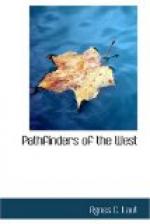The Crees got Radisson ashore, and there he lay in agony for eight days. The Indians were preparing to set out for the North. They invited Radisson to go with them. His sprain had not healed; but he could not miss the opportunity of approaching the Bay of the North. For two days he marched with the hunters, enduring torture at every step. The third day he could go no farther and they deserted him. Groseillers had gone hunting with another band of Crees. Radisson had neither gun nor hatchet, and the Indians left him only ten pounds of pemmican. After a short rest he journeyed painfully on, following the trail of the marching Crees. On the fifth day he found the frame of a deserted wigwam. Covering it with branches of trees and kindling a fire to drive off beasts of prey, he crept in and lay down to sleep. He was awakened by a crackling of flame. The fire had caught the pine boughs and the tepee was in a blaze. Radisson flung his snow-shoes and clothing as far as he could, and broke from the fire-trap. Half-dressed and lame, shuddering with cold and hunger, he felt through the dark over the snow for his clothing. A far cry rang through the forest like the bay of the wolf pack. Radisson kept solitary watch till morning, when he found that the cry came from Indians sent out to find him by Groseillers. He was taken to an encampment, where the Crees were building canoes to go to the Bay of the North.
The entire band, with the two explorers, then launched on the rivers flowing north. “We were in danger to perish a thousand times from the ice jam,” writes Radisson. “. . . At last we came full sail from a deep bay . . . we came to the seaside, where we found an old house all demolished and battered with bullets. . . . They (the Crees) told us about Europeans. . . . We went from isle to isle all that summer. . . . This region had a great store of cows (caribou). . . . We went farther to see the place that the Indians were to pass the summer. . . . The river (where they went) came from the lake that empties itself in . . . the Saguenay . . . a hundred leagues from the great river of Canada (the St. Lawrence) . . . to where we were in the Bay of the North. . . . We passed the summer quietly coasting the seaside. . . . The people here burn not their prisoners, but knock them on the head. . . . They have a store of turquoise. . . . They find green stones, very fine, at the same Bay of the Sea (labradorite). . . . We went up another river to the Upper Lake (Winnipeg).” [10]




